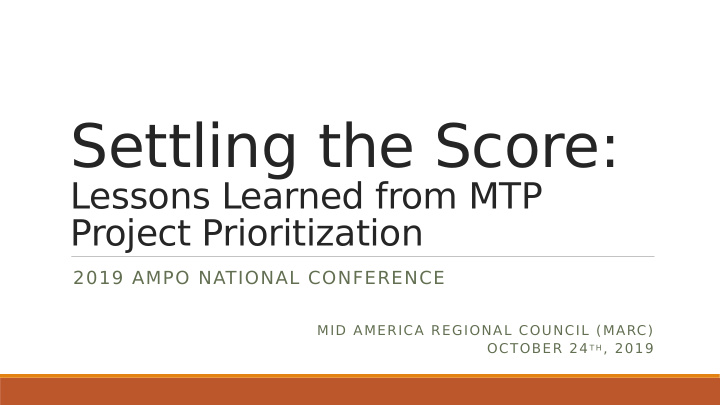



Settling the Score: Lessons Learned from MTP Project Prioritization 2019 AMPO NATIONAL CONFERENCE MID AMERICA REGIONAL COUNCIL (MARC) OCTOBER 24 T H , 2019
T oday’s MTP Update Lessons Include: Anticipate Database Responses (T esting Management 101 and QA/QC) Application Form & Wrangle T echnology Expectations
A Little Bit About the MARC Region • TMA (119 members) for Kansas City Area • Bi-State • More barbeque restaurants per capita than any other city • Guinness World Record for loudest crowd roar at a sports stadium – go Chiefs! • Birthplace of Mickey Mouse And most importantly… • New MTP will be adopted by June 2020
Lessons Learned * * *what my boss would not let me name this presentation
Application & Process • 15 page application • 39 questions • Fillable web form • Stafg held a workshop with project sponsors to explain the application and scoring criteria • Sponsors had 2 months to submit • Each stafg member had 2-3 questions they were responsible for scoring
What We Discovered • 419 projects total (stragglers still coming in) • Approx. 50% of responses were cut and paste • Median Score: 74/200 • Range: 8 – 165/200 • Application was too long • Data was not ready for scoring • T echnology was not used to it’s fullest potential • Many incomplete and missing applications • Poor quality answers
Responses We Didn’t Expect QUESTION: Please explain how the project or program provides multiple benefjts (triple bottom line - economic, environmental, social) in order to improve resiliency, i.e. a community’s ability to adapt to changes and challenges for long-term health and vitality? “The project will improve a sub standard roadway and provide social improvement by reducing concern while traversing the area.” – City who shall remain nameless
More Responses We Didn’t Expect… QUESTION: Specify if the project or program will serve one or more known environmental justice areas, or areas with hidden environmental justice populations by providing access to opportunities (i.e. jobs, education, reducing health disparities, etc. Map included with link to MARC EJ Guidebook) “This project will have facilities available that will benefjt all citizens.” – City who shall remain nameless
Seriously, How Do We Score These… QUESTION: Describe how the project or program will address transportation safety issue(s) identifjed in the Kansas City Regional T ransportation Safety Blueprint or local safety analysis. “Sidewalks provide alternative transportation.” – City who shall remain nameless
But We’ve Always Done It That Way… • Not mandatory to fjll in fjelds Applicati • Information went to an Access Database • Exported into excel for post processing (multiple times) on Issues • Mapped in SQL – not connected to Access • Did not require applications to submit maps • Not quantitative, barely automated • Allowed project sponsors to argue for more points Scoring • Unexpected responses received points – i.e. congestion management Issues • All sections were equally weighted – diffjcult to prioritize • Stafg members submitted certain projects – questionable scoring
Database Management (Or Lack Thereof) Things we didn’t consider… Mapping out a The backend process fmow in database Where the How the form is advance with a structure/Identify information is hosted online timeline and fjelds needed for collected responsibilities post processing Mapping projects Designing it to Matching projects Process for required SQL and automate scoring from our current making updates to our application (to the extent MTP – No unique applications was set up in reasonable) identifjer Access
MARC Environment Public Public
Setting Expectations Staf • How well can we expect a project sponsor to anticipate the efgects of their project on the PMs at this stage? How should we expect them to demonstrate/justify those efgects? • Also, is this level of analysis/scoring more appropriate at the time of sub-allocation applications? • What is the anticipated work efgort and time needed for the technical lifts? Partners • Do we accept incomplete applications? If so, what criteria are they allowed to not answer? • Do we establish a bare minimum for inclusion in the plan? If a project scores 0 do we allow that or do we require them to revisit their project and make it better? • Do we allow projects that add capacity on segments not identifjed as congested through our CMP? What is Expansion vs “Modernization”?
Proposed Solutions
How We Plan to Get Better Applications Skip the open-ended - Quantitative over qualitative as much as possible Shorten - Don’t ask information we already have (Activity centers, mobility hubs, etc.) Prepare our sponsors better - Focused application training, vetting and expectation setting Integrate QA/QC - Have project sponsors actually test the application and have stafg score Leverage data and technology to make the process simpler for everyone – interactive web map!
MARC Environment Public Public
MTP Data Management Plan(ish) Public Environment MARC Environment
Interactive Web App (Prototype - don’t judge us) • Allows Sponsor to draw in geometry • Seamless connection with Insert screenshot of mock up here SQL database/website • Requires all fjelds be answered • Allows stafg to analyze against other datasets/layers • Allows Sponsor to make edits • Institutionalizes change
Contact Caitlin Zibers Mid-America Regional Council 816.701.8319 czibers@marc.org
Recommend
More recommend